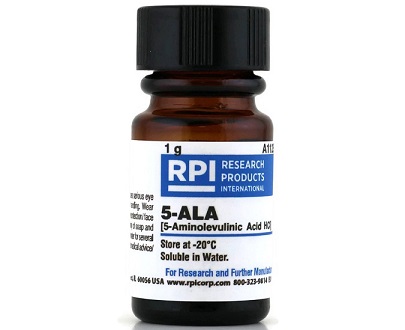COVID-19 News: 5-Aminolevulinic Acid (ALA) Emerging As A Potential Safe And Effective Antiviral Against SARS-CoV-2 Infections
COVID-19 News - 5-Aminolevulinic Acid (ALA) Apr 09, 2023 2 years, 8 months, 4 weeks, 1 day, 5 hours, 32 minutes ago
COVID-19 News: As the world continues to grapple with the COVID-19 pandemic, a natural amino acid, 5-aminolevulinic acid (ALA), is emerging as a potential antiviral for SARS-CoV-2 infections. This groundbreaking discovery could pave the way for an innovative treatment strategy that targets the angiotensin-converting enzyme 2 (ACE2) receptor, which plays a critical role in the virus's ability to infect human cells.

Numerous research in the last two years have highlighted the potential of ALA as a promising treatment strategy for COVID-19. This essential amino acid, which is naturally found in the human body and has low toxicity, can be transformed by cells into protoporphyrin IX (PpIX) and heme. The latter serves as a precursor for hemoglobin and other vital proteins. By examining the effects of ALA on the expression of ACE2, scientists have discovered a possible link between the molecule and the suppression of ACE2, a receptor that SARS-CoV-2 uses to enter and infect host cells.
A key aspect of ALA's potential as a COVID-19 treatment lies in its ability to suppress the expression of ACE2 in host cells, thereby preventing the virus from binding to and infecting them. When administered alongside sodium ferrous citrate (SFC), an iron source, ALA's effectiveness in inhibiting SARS-CoV-2 infectivity can be significantly enhanced. This combination results in a decrease in ACE2 expression and an increase in intracellular heme levels, suggesting that heme production plays an essential role in this process.
The connection between ALA, PpIX, and heme production is further reinforced by the observation that inhibiting heme oxygenase-1 (HO-1), an enzyme involved in heme degradation, also leads to a decrease in ACE2 expression. This suggests that both heme production and HO-1 may be crucial factors in suppressing ACE2 expression and, ultimately, SARS-CoV-2 infectivity.
The role of G-quadruplex (G4) structures as covered by many studies and past
COVID-19 News coverages in inhibiting SARS-CoV-2 replication adds another layer to the potential therapeutic applications of ALA. G4 structures are nucleic-acid secondary structures that can form in single-stranded DNA and RNA guanine-rich sequences under physiological conditions. Previous research has demonstrated that porphyrins, including PpIX and hemin metabolized from ALA, are capable of binding to G4 structures, offering a potential therapeutic strategy for combating COVID-19.
One particularly noteworthy aspect of ALA is its safety profile. The amino acid has been used in photodynamic diagnosis and therapy for various cancers, with minimal side effects reported. This suggests that developing ALA as an antiviral agent is a realistic and viable plan. Furthermore, while initial concerns were raised about the use of ACE inhibitors as drugs for treating COVID-19 patients, no scientific evidence currently supports the idea that they are potentially harmful.
In conclusion, ALA, combined with an iron source like SFC, offers a promising new approach to treating COVID-19 by suppressing ACE2 expression and reducing SARS-CoV-2 infectivity. By harnessing the power of this natural amino acid, researchers and medical professionals may be able to develop a novel, effective therapy that coul
d play a crucial role in the global fight against COVID-19. As we continue to explore the potential of ALA and further our understanding of its mechanism of action, we move one step closer to discovering a much-needed cure for this devastating disease.
There are currently a number of clinical trials underway in Japan, Taiwan and Indonesia on using 5-aminolevulinic acid (ALA) to treat COVID-19.
References:
Antiviral activity of 5-aminolevulinic acid against variants of severe acute respiratory syndrome coronavirus 2
https://pubmed.ncbi.nlm.nih.gov/34991723/
Suppression of angiotensin converting enzyme 2, a host receptor for SARS-CoV-2 infection, using 5-aminolevulinic acid in vitro
https://pubmed.ncbi.nlm.nih.gov/36757984/
5-amino levulinic acid inhibits SARS-CoV-2 infection
in vitro
https://pubmed.ncbi.nlm.nih.gov/33571909/
Therapeutic potential of 5-aminolevulinic acid and sodium-ferrous citrate for viral insults: relevance to the COVID-19 crisis
https://pubmed.ncbi.nlm.nih.gov/34927515/
Construction of 5-aminolevulinic acid synthase variants by cysteine-targeted mutation to release heme inhibition
https://pubmed.ncbi.nlm.nih.gov/36089467/
Antiviral Effects of 5-Aminolevulinic Acid Phosphate against Classical Swine Fever Virus: In Vitro and In Vivo Evaluation
https://pubmed.ncbi.nlm.nih.gov/35215109/
Case Reports: Safety, Tolerability, and Efficacy of 5-Aminolevulinic Acid Phosphate, an Inducer of Heme Oxygenase 1, in Combination with Sodium Ferrous Citrate for the Treatment of COVID-19 Patients
https://opencovidjournal.com/VOLUME/1/PAGE/52/FULLTEXT/
For the latest
COVID-19 News, keep on logging to Thailand Medical News.
